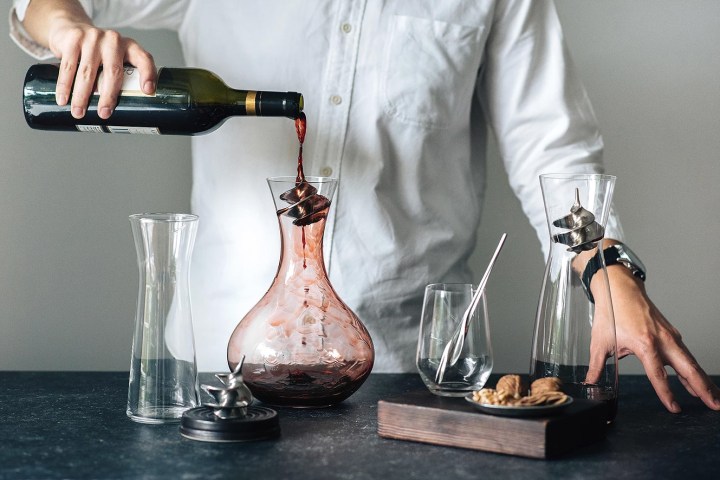
These are two very different devices. The Velv is $200 and looks like a stick blender or milk frother. It has a bulbous cap where you insert an oxygen cartridge and a skinny wand you insert into a wine bottle. It takes oxygen from the 99.5-percent oxygen capsule and mixes them with the wine via microbubbles created by the diffuser. The Woo Collective decanter cap is a tin doohickey that looks like a shrunk-down spiral sculpture. It sticks in a decanter and looks like a toy top or fancy fidget spinner. The company says tin removes bitterness from wine and alcohol, and it makes a swizzle stick version for liquor.
The theory is that leaving your wine bottle uncorked overnight causes it to oxidize and taste terrible. Decanting it also exposes it to oxygen but can open up the wine, introducing new flavors and mellowing it out.
Trying the Velv and Woo
To use the Velv, first you’ll want to pour a bit of wine out into a glass. The company says it’s so you can taste the difference, but the one time I didn’t do this, the little bubbles caused the wine to froth out of the bottle and onto the counter. The wine isn’t bubbly when the process is over; so don’t worry about turning your chardonnay to sparkling wine.

Each oxygen capsule provides 30 minutes of oxygenating, so how many bottles you can get through depends on how long you leave it running. Different types of wine have different time requirements. Whites such as sauvignon blanc and riesling take two or three minutes. Merlot and tempranillo need four or five. Nebbiolo requires seven to nine.
Stick the wand in the bottle, twist the cap, and let it run.
For the Woo Collective tin decanter cap, I had some trouble finding a proper vessel. You’re supposed to stick it in the neck of your decanter and pour wine over it, letting it swirl around the curves. My decanter is a pretentiously weird shape, and the tin gizmo didn’t fit. It wasn’t wide enough to fit any of my glasses, either. I finally found a suitable vessel in a water bottle my sister gave me for being her maid of honor.
We did a taste test!
To see if either the Velv or the Woo Collective decanter cap really made a difference, I bought a bottle of $7 wine and gathered three friends. Velv says its device works best with young reds such as cabernet sauvignon, merlot, bordeaux, zinfandel, and syrah. My $7 bottle was a red blend. I ran the Velv for five minutes. To make the taste test a little scientific, I labeled cups A, B, and C on the bottom, then poured in wine straight from the bottle, wine that had been poured over the tin decanter, and wine that had been oxygenated with the Velv. No one knew which was which, and everyone tried to guess and then picked a favorite.

Everyone correctly picked the wine that had been treated with the Velv and chose it as their favorite. Two people mixed up the untreated wine and the one that had been used with the Woo Collective. Everyone agreed all the wines tasted different, but it was hard to pinpoint exactly what was different about the wine from the bottle and the one that I poured over the decanter. Some said the original had more bite, while others said the decanted one was more acidic.
For the Velv wine, the taste was noticeably smoother. It was also easier to pick out different tasting notes. I say that as a person who drinks boxed wine. I don’t know what those notes were, but I could taste them.
Too expensive for bottom-shelf wine?
The $110 Woo Collective decanter is a one-time fee, but the Velv requires you to shell out $25 for a two-pack of oxygen capsules, which last for five to 10 bottles. I was using it to make bottom-shelf wine taste palatable, but with that kind of price, it seems aimed at people who want to bring their pricey but young wines to a new level.


